
As the pandemic enters its third year, the Omicron variant of SARS-CoV-2 has become the dominant strain globally. Due to the nature of the virus and other reasons, the spread of the omicron variant is predicted to worsen as temperatures in the northern hemisphere begin to decline. Fever, severe respiratory disease, or pneumonia are the characteristics, but there are increasing reports about the effects of COVID-19 and Omicron on patients’ ocular health. This article aims to inform the reader about how COVID-19 and the Omicron variant affects the eyes of patients and how to prevent visual impairment in the post-pandemic period.
COVID-19 and Visual Impairment Cases
The COVID-19 virus is transmitted from person to person by respiratory droplets. Pneumonia develops once the virus affects the lungs. Then, it affects almost every organ of the body, including your brain and eyes. Specialists and experts from all around the world have reported various manifestations of infection in the eye. In short, vision loss or visual impairment may be the symptom of COVID-19 infection among some patients, or it may appear several weeks after recovery.
Lots of research indicates that ocular symptoms, or worse, vision loss or visual impairment frequently correspond to the severity of the disease. According to a recent meta-analysis review from Al-Namaeh (2021), the prevalence of ocular manifestations in COVID-19-infected individuals ranged from 2% to 32%. And based on data so far, 1%-3% of people with COVID-19 will get conjunctivitis, also called pinkeye.
Symptoms of Visual Impairment Caused by COVID-19
According to research published in the journal JAMA Ophthalmology, COVID can cause a broad range of ocular symptoms, from diseases of the anterior segment like conjunctivitis and anterior uveitis to those that might impair vision like retinitis and optic neuritis. Similarly, on WHO’s list of potential COVID-related eye symptoms is viral conjunctivitis (namely pinkeye). Other eye symptoms include chemosis, epiphora, increased secretions, fibrin pseudomembranes, inflammatory cells on the tarsal conjunctiva, and a feeling of a foreign body being in the eye.
Conjunctivitis, the main indicator of COVID-19-related vision impairment
Conjunctivitis, also called pinkeye, happens when the virus infects a tissue called the conjunctiva, which covers the white part of the eye or the inside of the eyelids. Symptoms of conjunctivitis include:
-
-
- Red
- Swollen
- Itchy
-
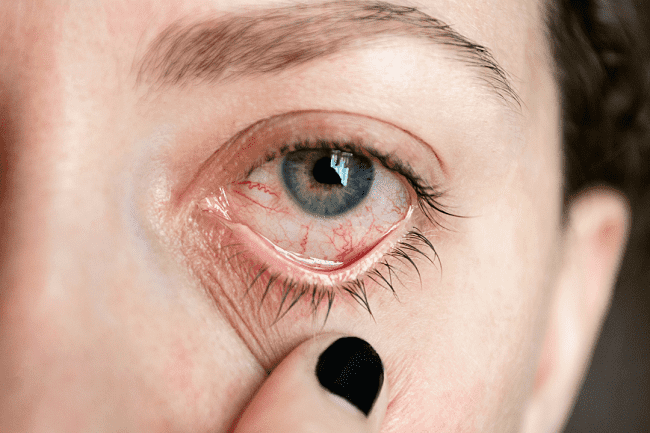
Conjunctivitis can cause vision loss or visual impairment, or even legal blindness in some patients, but in the majority of instances, the condition heals entirely without causing any long-term problems. Of course, conjunctivitis caused by underlying diseases has a possibility of recurring over time. The CDC reports that COVID symptoms often show 4 to 5 days after exposure (if they appear at all), but they might take as long as 14 days to appear after exposure. Of course, if you have conjunctivitis, it doesn’t necessarily mean you have COVID-19. The more likely causes are the many different viruses, bacteria, chemicals, and allergens that can irritate your eyes. Many forms of conjunctivitis go away with over-the-counter treatments in about 1-2 weeks. But if you also have a fever, cough, or shortness of breath, ask your doctor what you should do.
Keratoconjunctivitis, signs of COVID-19-related vision impairment
Keratoconjunctivitis means that you have both keratitis and conjunctivitis at the same time — it is a set of inflammatory eye diseases affecting the conjunctiva and the cornea. The main causes include germs, viruses, and allergies. Some symptoms associated with keratoconjunctivitis are as follows:
|
redness |
swollen eyelids |
|
watering |
light sensitivity |
|
stickiness |
itchiness |
|
dryness |
minor blurring of vision |
(cf. https://www.healthline.com/health/keratoconjunctivitis#summary)
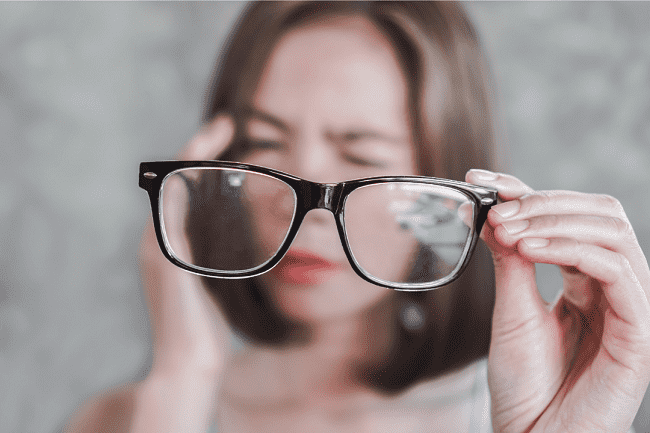
Treatment of keratoconjunctivitis depends on the cause and severity of the symptoms. Some people may need to take prescription drugs. Others might get relief from an over-the-counter medication or by making some changes to their lifestyle. One particularly contagious form of keratoconjunctivitis is epidemic keratoconjunctivitis (EKC). People washing their hands thoroughly and frequently, especially after touching their faces could reduce the likelihood of spreading it. Of course, the safest option when experiencing the aforementioned symptoms is to call your eye doctor right away to schedule an appointment for a thorough eye examination. Early treatment is necessary to prevent worsening vision impairment.
How to Prevent Visual Impairment during the post- COVID-19 period?
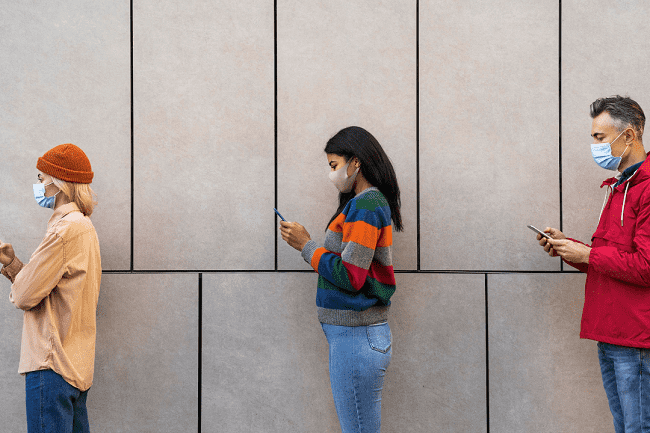
Research has demonstrated that COVID-19 and severe acute respiratory syndrome coronavirus-2 (SARS-CoV-2) love a chilly and dry environment, particularly in some conditions lacking direct sunlight. Especially in the winter, with dry indoor air and poor ventilation conditions (in most cases, indoor heating keeps the room temperature at around 20 degrees Celsius), indoor environments are ideal for the coronavirus’s stability. The potential for COVID-19 and SARS-CoV-2 version transmission rise because people are more inclined to engage in indoor social activities with poor ventilation during the winter. Common Measures taken to restrict the outbreak, such as social isolation and mask-wearing, are still useful.
Pay attention to hygiene procedures (including eye hygiene)
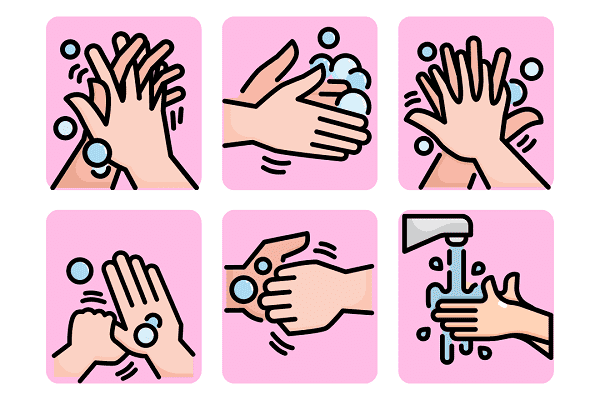
Cover your nose and mouth with a tissue when coughing or sneezing, and wash your hands frequently. Avoid unwashed hands touching your face, especially the mucous membranes in your mouth, nose, and eyes.
Many people are ignoring proper eye hygiene. While the risk of coronavirus spreading through tears appears small, it may survive in the conjunctiva, even in the absence of signs of conjunctivitis, suggesting the importance of using eye protection to avoid infection from external droplets and aerosols. It should be noted that ocular surface cells are susceptible to coronavirus infection because they can create TMPRSS2, an enzyme that helps the virus enter, and then, the respiratory cells could become infected as a result of the virus spreading through the tear ducts that link the eyes to the nasal cavity.
Maintaining good eye health can also lower your chance of developing additional eye conditions or vision loss. For example, avoid rubbing your eyes. It can be difficult to break the habit, but drops of moisture may reduce itching, or if you must contact your eyes, use a tissue instead of your fingers.
Wearing masks and eye protection
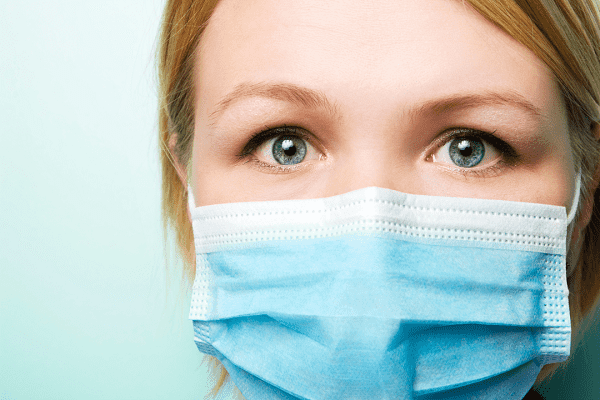
Please remember to keep 6 feet away from others and wear a mask if you go out. Your spectacle lenses might aid in shielding your eyes from any respiratory droplets. Wear sunglasses if you don’t wear glasses.
For visually impaired individuals, it is time to wear your low vision glasses or wearable electronic glasses, like AR or VR E-glasses. People who are living with visual disabilities/impairment are more susceptible than those without them to contracting the severe acute respiratory syndrome coronavirus-2 (SARS-CoV 2).
The legally blind or visually impaired are more likely to be injured owing to falls that might cause secondary medical issues or bone fractures. Therefore, wearable electronic glasses could protect them from mishaps that could result from poor vision in their daily activities. IrisVision Inspire, Zoomax Acesight Series, and eSight are examples of high-quality, distinctive products of wearable electronic magnifiers or low vision E-glasses.
Learn more about How to choose the right low vision device?
No evidence shows that using contact lenses increases the risk for COVID-19 more than those who wear eyeglasses. However, you should keep up your safe hygiene routines when wearing and taking care of them. At the very least you should wash your hands before putting them in, or taking them out.
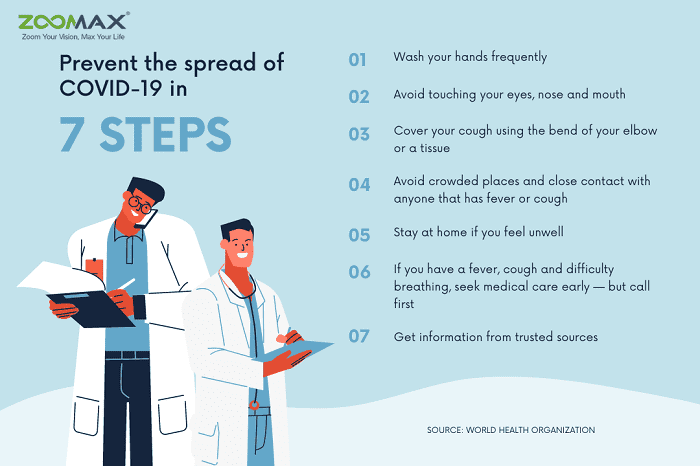
Stock up on eye medication and low vision devices in advance
If you take eye drugs regularly or have an eye disease, find out from your eye doctor or pharmacist whether you can order glaucoma drops and other necessary medicines in advance. Possible options include a three-month supply.
Similarly, for people who are already visually impaired or have had eye surgery, it is necessary to choose and purchase the right low-vision aids in advance because the pandemic will also cause supply and logistics issues worldwide. Low-vision devices for people with visual impairment—whether low-vision E-glasses, handheld electronic video magnifiers, or desktop electronic video magnifiers—will greatly enhance their quality of life and reduce the risks related to their condition, especially if they have to spend more time indoors.
When selecting a low-vision video magnifier for home or office usage, you should consider the product’s stability and usability in addition to the screen size and image quality. The newly presented Zoomax Luna HD 24 Pro large-screen desktop video magnifier is one of these products for visually impaired people living with macular degeneration, glaucoma, and other types of vision loss conditions.
Learn more about How to choose the right low vision device?
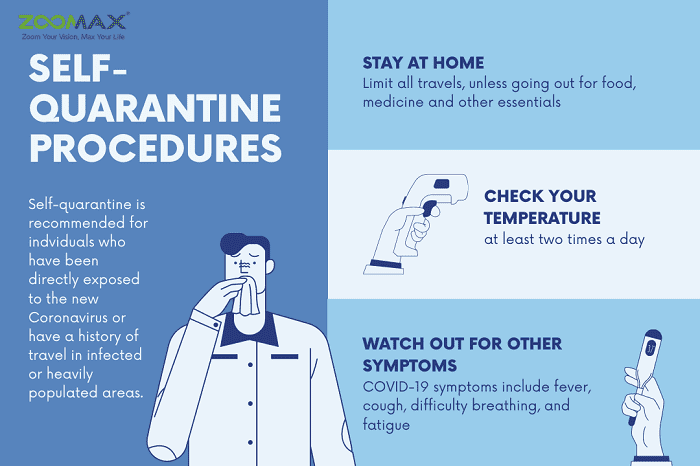
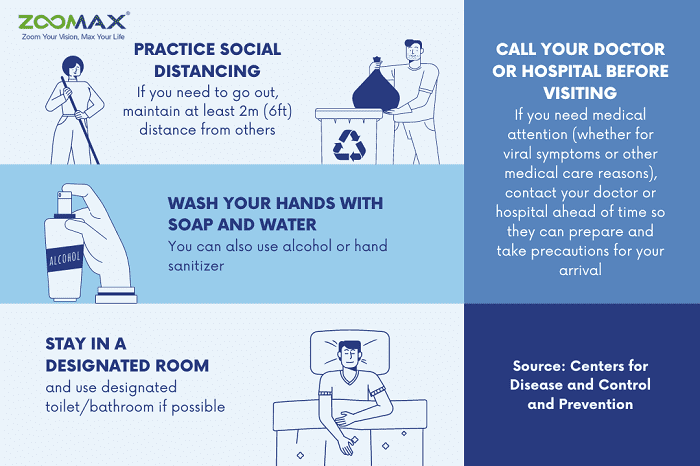
Prevention of COVID-19 Transmission
Even while the chance of COVID-19 transmission rises as the weather gets colder, you can still significantly lower the risk of infection by taking good care of yourself. Avoid crowded places and close contact with anyone that has a fever or cough. Stay at home if you feel unwell, and stay away from COVID-19 patients until they are secure enough (see Self-quarantine Procedures). Sometimes it may not be possible to avoid someone who has COVID-19, or you might want to help in their care.
Take as many preventive measures as you can, including maintaining good hand cleanliness, wearing a high-quality mask at all times, improving ventilation, and maintaining a safe distance. Also, put on wearable low vision glasses, E-glasses, safety glasses, or goggles if you are caring for a sick person.
Whatever the possible cause of your symptoms, you should see an eye doctor if you notice any significant changes in your vision or the color or consistency of your eye discharge. Remember, before visiting a hospital or medical facility, call to find out if it’s safe to do so and to get any arrival instructions.
Reference
Al-Namaeh, M. (2021). COVID-19 in the light of current clinical eye research. European Journal of Ophthalmology, 31(3), 904–908. https://doi.org/10.1177/1120672121998911

